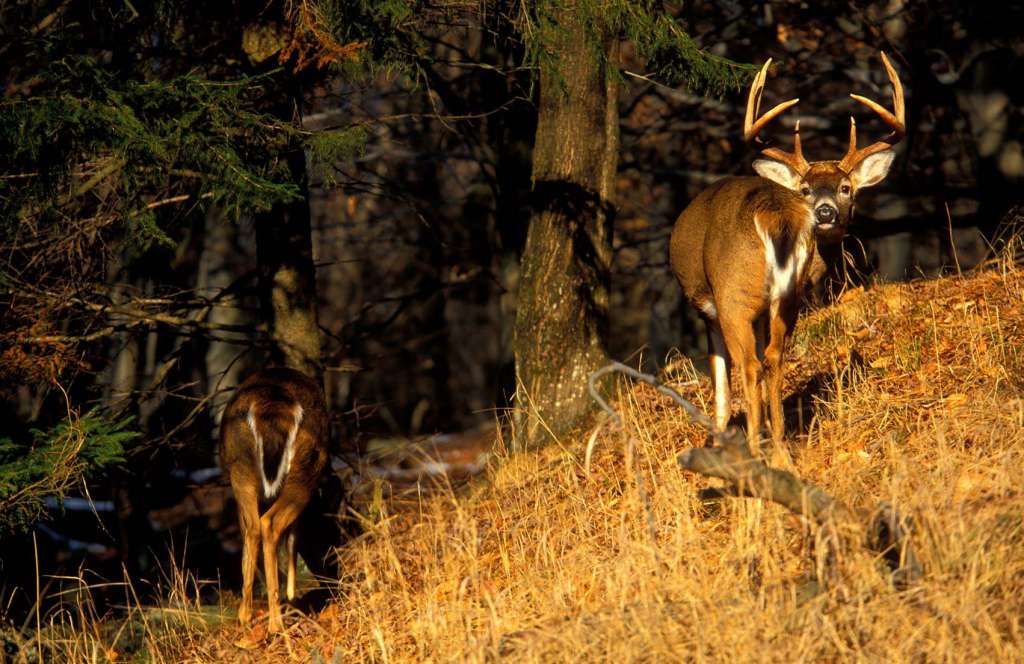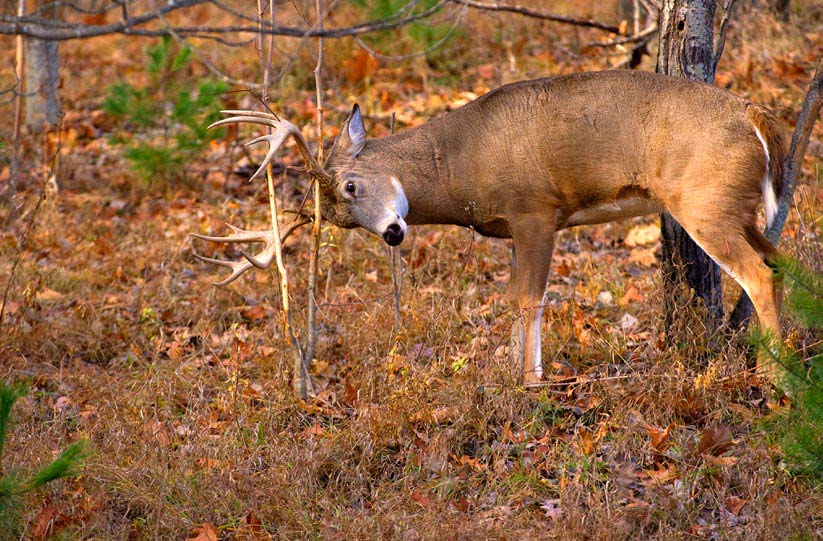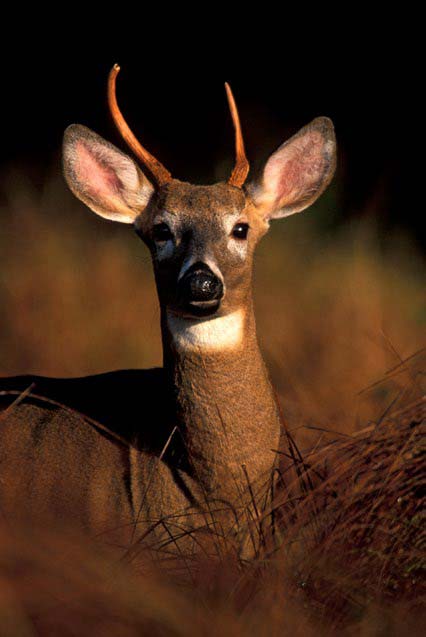Understanding the nuances of Whitetail behavior has been the obsession of many a hunter over the decades. Correctly interpreting buck sign like rubs and scrapes, unraveling the truth as to whether or not deer can see colours, and discovering where huge bucks hide out have all intrigued deer hunters. These as well as many other aspects of the Whitetail world supplied us with great sources of speculation and debate over the years; some based on fact, others more on myth. Correctly interpreting and understanding deer behavior is what gives some hunters the edge over others. Here are ten of the most common deer myths and the truth behind them.
1. Small rubs are made by small bucks
The sight of a fresh buck rub of any size gets most hunters excited. But when those bigger trees (4-inches + in diameter) are all carved up, it gets the blood flowing through any hunter’s veins! But do we really need to find those big rubs that look like they’ve been carved by a small chainsaw? Should we become excited when we find a grouping of smaller trees where the bark’s been rubbed off? Quick answer: Yes! Fresh rubs are always one of the best indicators that a rutting buck is or at least has been patrolling the area. Sure big rubs are always made by big, mature bucks, as smaller males don’t have the antler size or strength to make rubs of that stature. It’s a fact that smaller bucks do make small rubs. But… mature bucks will also rub small trees. So if you find an area that has not one, but several smaller rubs within sight of one another, odds are, since there’s a grouping of rubs, that a mature buck was the maker.
2. Food plots will keep bucks on your property
Planting secluded food plots on any property can undeniably increase the appeal of that land to deer. Food plots can be a great deer draw from summer through to mid-autumn, and again in late fall, depending on what’s been planted and if there’s not too much snow.
However, come Late-October there’s something that a buck starts thinking about that far outweighs food…. sex. As soon as does come into heat, bucks roam much larger territories and no longer focus their daily travels to arrive at their favorite food source. In fact, eating becomes a low, to virtually nonexistent priority compared to tracking and chasing does. Bucks no longer stay on the same 200 acres that they did during before the rut – the pre-rut is your best chance for a planted food plot to increase your odds of harvesting a buck. Once the rut starts, a buck’s range will increase exponentially and the draw of even the best placed and lushest food plot won’t keep him there. So focus your hunting efforts over food plot during bowseason.
3. Bucks always bed in the thickest, dirtiest areas of their home range
It’s true that mature bucks most often bed in the most densely vegetated areas of their territory. A small rise within a dense evergreen swamp is one example of a favorite buck bedroom. However, there is no golden rule when it comes to trophy buck’s bedding areas, especially if another hunter has hiked through and is subjecting the bedding area to human pressure or scent. Mature bucks are very adept at disappearing and readily opt to bed in other hiding areas of their home range. They may spend the day in a tiny acre bushlot along the end of a field, or on a hardwood ridge overlooking much of the forest around and below them, in a standing corn field, even in a thicket along a field drainage. Two years ago one a buddy of mine was testing the sights on his rifle a few days prior to the season opener. It was high noon and he was at a friend’s farm where he elected to shoot his gun at a tree trunk that was at the base of a 20-foot pile of dirt in the middle of a 10-acre field. After he fired his first shot he was shocked and amazed to see a mature 8-point buck quickly step out from the far side of the large mound! The buck had been bedded there! One of those locations that no one would ever expect to find a deer. And guess what… my friend didn’t see that buck again once the season opened. The buck probably found another unlikely place to hide out during the daylight hours where no one was likely to look.
Knowing that when bucks are under pressure they’ll quickly switch-up their daybed locations should only encourage us to always be alert and watchful for a bedded buck, even in the least likely of locations.
4. Bucks never rub the same tree twice
Some hunters believe that once a buck has used the gnarly base of his antlers to tear the bark off of a tree that he’ll never grind his rack on that tree again. It’s true that bucks don’t rub the same tree often in the way that they re-work a scrape practically every time that they walk past it, but they have been known to rub the same tree more than once. In fact, some favorite trees even get rubbed year after year. Sometimes another buck will briefly rub a tree that’s already been scarred up by a different male…presumably to deposit the scent from his own forehead glands in a statement of claiming the turf as his own, or offering a challenge. Even though they’re not re-visited in the manner that scrapes are, rubs do effectively draw the attention of other passing deer and can be rubbed more than once.
5. Bucks don’t use the same runways as other deer
True, mature bucks are typically loners that avoid the same trails that other deer use – especially doe groups. However, come mid-autumn, when bucks’ minds switch into ‘rut mode’ they’re suddenly drawn to the more traveled runways. It’s the scent of the does that lures them to use the main deer trails that connect bedding and feeding areas. So for a few weeks each year, and thankfully those weeks typically correspond with deer season, bucks become less cautious and use the larger, primary deer travel routes. Finding the main deer trails on a property is far easier than pinpointing hidden, barely worn buck paths. So next season, key in on main trails during the beginning of the rut.
6. A buck that’s been shot at will run a long way
Once upon a time, I would’ve believed that if someone fired a rifle at a buck and missed, it would hi-tail it right out of the area! However, experience has taught me that deer can’t always figure out where that sudden loud noise came from, and they often stop as soon as they gain the security of the forest. Sometimes a deer can be so confused about the direction of the shot sound that it may even stand still while it’s being shot at a few times before it starts to flee. A few years ago when at our family deer camp, I had a pair of does appear and begin to cross the frosty hydro line where I was watching. It was the first week of November, and odds should’ve been good that two perfect-looking does would have a buck in tow. After the does had just disappeared into the far side of the hydro cut, a rifle shot rang out to my right. My uncle, who was positioned about 200 yards up the cut from me, had just fired at a heavy-bodied 8-pointer that had appeared from the forest. The buck was heading in the same direction as the does. As quickly as the shot split the silence of the morning the buck had turned and within two jumps had regained the concealment of the woods. My uncle had missed his opportunity and I figured that would be the last we’d see of that buck. To my disbelief, the buck popped back out within a couple of minutes, this time 100 yards closer to my position, still apparently following the doe trail. That morning had a happy ending for one hunter.
7. Finding antler shed can show you where to hunt next autumn
Few things can spark excitement like finding a big set of antler sheds. They’re great keepsakes and they’re proof that the buck made it through the rigors of the rut and survived the previous autumn’s hunting season, and will hopefully make it through to the upcoming fall. However, the location of sheds doesn’t necessarily help a hunter pinpoint where to expect to find that animal next autumn. In northern regions, deer in many areas migrate to a wintering yard once the snow accumulates. Meaning that they often have a different wintering range than their autumn haunts. The exception to this is a property that already holds a wintering yard. If deer spend the winter on the same property where you hunt, then most of those same animals will be there come next autumn – but not all. Others will leave in the spring to migrate a few kilometers back to their spring and summer range. How do you know which stay and which leave? My best recommendation is to scout with a trail camera from July 1 through to deer season – or even better, leave them up year-round!
8. Bucks only make scrapes during the rut
Yes, the vast majority (90% or more) of scraping action takes place from mid-October through until the end of November each year. However, believe it or not, there may be a couple of scrapes on a property that bucks will continue to paw at and work the licking branch year-round! We had one of these 365 scrapes on one of the properties where I hunt – well at least until the licking branch finally wore out and snapped off – I was able to resurrect it by attaching a new overhanging branch with a couple of twist-ties, positioning it at the same height and location.
The variables that encourage bucks to work a particular scrape all year are not only it’s secretive location (typically a small opening in the woods near a feeding area – a buck staging area) and a suitable licking-branch, but it’s also important that a few adult bucks live in the area. These bucks will feed off of each other’s energy during the winter, spring, and summer, as they routinely keep working such a scrape. If you can find a scrape that’s kept active throughout the seasons where you hunt, then make sure to devote hunting time to that area come autumn!
9. Yearling spike bucks will not grow big racks when they mature
It’s true that some yearling males are slow out of the starting gate when it comes to antler growth. Yearling racks can range from a smallish, short-tined, thin 10-point frame to a straightforward set of 4-inch spikes. At first glance, one would guess that the yearling bucks with the bigger racks would always have an edge and end up with the most impressive antlers upon maturity. This is often the case, but it’s not a steadfast rule. Some bucks that grew spikes as yearlings do find a way to catch up through their teenage years and produce impressive antlers when mature. I liken it to our own teenagers, some have their growth spurt and reach their full height when they’re 13, while others might not complete their vertical development until their late teens. So don’t rule out the potential of scrawny little spike bucks….in a few years they may end up providing you with your next taxidermist bill.
10. A large-racked buck will produce buck fawns with the same large rack configuration
First off, big bucks naturally produce both male and female fawns. When they sire a male offspring the odds are that a huge trophy-sized buck will likely produce buck fawns that will have large antlers upon maturity. Genetics is a key factor in antler configuration and can also influence size. Nutrition is another key variable. So the male offspring, when they relocate to a new home range as yearlings, would have to find one with comparable nutritional forage to allow for equally impressive antler growth. However, there is one other key element to consider when it comes to a buck fawn’s antler potential at maturity – the doe’s genetic makeup. Yes, that’s right, the genetics of the doe can also influence the size and configuration of the next generation’s antlers. So even if there’s a perfect, heavy beamed 12-pointer breeding most of the does in your area, not all of the male offspring will grow up to mirror his appearance, but the good news is some will…
By Mark Raycroft
Want more like this? Read Mark’s article on understanding and predicting deer movement.
Per our affiliate disclosure, we may earn revenue from the products available on this page. To learn more about how we test gear, click here.










